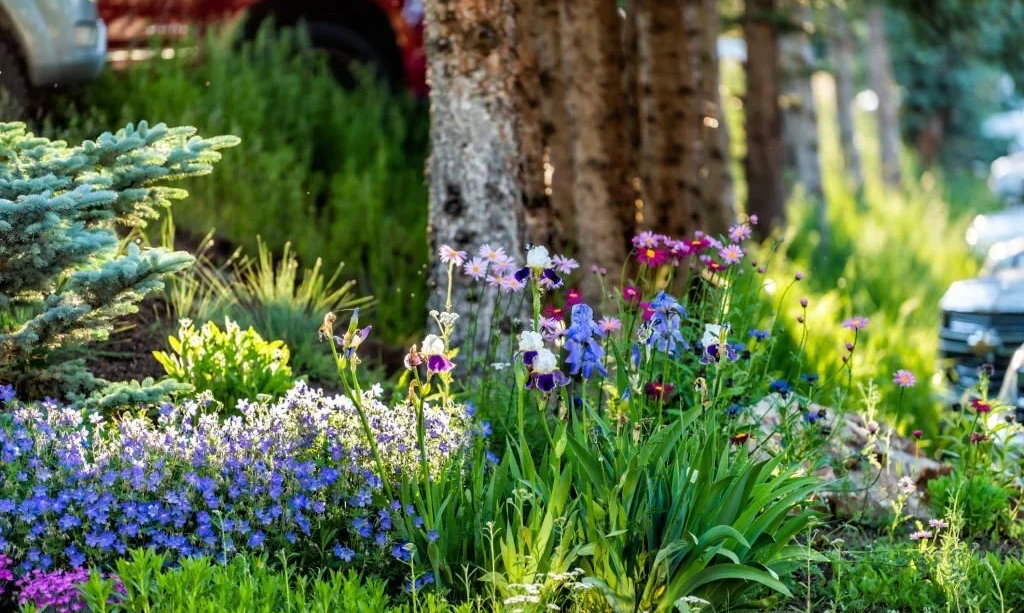Welcome to the world of iris plants, where beauty and elegance take center stage! Iris flowers have captivated gardeners for centuries with their vibrant colors and delicate petals. In this guide, we’ll explore the art of companion planting with iris, helping you choose the perfect plants to enhance the beauty of your garden. Get ready to discover the secrets of creating a stunning floral display that will leave you and your guests in awe.
- Pollinator
- Attracts Butterflies and Hummingbirds
- Loves Sun
- Super Fragrant
- Easy to Grow
Iris
Let’s take a moment to get to know the iris a little better. Iris plants are known for their stunning flowers, which come in a wide range of colors, including purple, blue, yellow, and white. They have distinctive petals with intricate patterns that resemble brush strokes, adding an artistic touch to any landscape. Irises come in different varieties, such as bearded iris, Siberian iris, and Japanese iris, each with its own unique characteristics and growing requirements.
Irises are perennial plants, meaning they come back year after year with proper care. They prefer well-draining soil and thrive in sunny locations, although some varieties can tolerate partial shade. With their graceful upright stems and sword-shaped leaves, irises make a bold statement in the garden and are often used as focal points or accents in flower beds or borders.
Now that we have a glimpse of the enchanting world of irises, let’s dive into the exciting realm of companion planting to make your iris garden even more enchanting!
Factors to Consider When Choosing Companion Plants
When selecting companion plants to accompany your iris, there are a few important factors to keep in mind:
- Complementing Colors: Consider choosing plants with colors that harmonize or contrast with the blooms of your iris. This can create a visually pleasing display that enhances the beauty of both plants.
- Similar Growing Conditions: It’s important to select companion plants that have similar sunlight, soil, and water requirements as iris. This ensures that all plants in the grouping will thrive together.
- Height and Growth Habits: Think about the height and growth habit of your iris plants and choose companion plants that complement them. This can create a balanced and aesthetically pleasing arrangement, with shorter plants in front and taller plants behind.
- Bloom Time: This Summer to Fall Frost
- Light Requirements: Full Sun/Partial Shade
- Fill your garden with an immense burst of Summer color this year from July through Early October! Are you new to bulb gardening looking to just get your hands dirty? This is the collection for you.
- Included In This Package: 18 Tutti-Frutti Gladiolus, 40 Harlequin Flowers, 10 Stargazer Lilies, 5 Mixed Asiatic Lilies, 5 Mixed Calla Lilies (78 Total Bulbs).
- Hardiness Zones: 3-9
Suitable Companion Plants for Iris
Now, let’s explore some suitable companion plants that can make your iris garden truly spectacular:
- Perennials: Consider planting perennials alongside your iris. Daylilies, with their vibrant and long-lasting blooms, make an excellent companion. Lupines and peonies can also provide a beautiful backdrop to your iris plants, adding depth and texture to the overall display.
- Bulbs: Planting bulbs that bloom around the same time as iris can create a stunning combination. Daffodils, tulips, and alliums are great choices. Their vibrant colors and diverse shapes add a touch of elegance to the garden, complementing the iris blooms.
- Ornamental Grasses: Adding ornamental grasses to your iris garden can provide a graceful and flowing effect. Fountain grass or maiden grass, with their slender and swaying blades, create a lovely contrast to the structured and upright nature of iris plants.
- Ground Covers: Consider using low-growing ground covers to create a colorful carpet under your iris plants. Creeping thyme or creeping phlox can add a burst of color and fill in the spaces between iris clumps, creating a visually pleasing ground cover effect.
By selecting the right companion plants, you can create a garden that is bursting with color, texture, and variety. Remember to consider the factors mentioned earlier to ensure a harmonious and balanced arrangement in your iris garden. Now, let’s dive into some design tips and maintenance techniques to make your iris and companion plants thrive together!
Design Tips for Planting Iris with Companions
Now that you have chosen the perfect companion plants for your iris, it’s time to get creative and design a visually stunning garden. Here are some tips to help you make the most of your iris and companion plant arrangement:
- Grouping and Contrast: Plant iris and their companions in visually appealing groupings. Consider color combinations and contrasts to create eye-catching displays. For example, plant purple iris alongside yellow daylilies for a striking contrast, or pair blue iris with white peonies for an elegant and serene combination.
- Layering Heights: Create depth and visual interest by planting taller companion plants behind the iris and shorter ones in front. This layering effect adds dimension to your garden and allows each plant to shine without overshadowing the others.
- Seasonal Interest: Select companion plants that bloom at different times throughout the year to ensure continuous beauty in your garden. This way, you can enjoy a variety of colors and textures even when iris are not in bloom. Mix early spring bulbs with summer-blooming perennials for a garden that delights you all season long.
- Best nutrition for your iris plants
- Improves iris bloom
- Improves health of iris plants
Maintenance and Care Tips
To ensure the health and vitality of your iris and their companion plants, here are some maintenance and care tips:
- Proper Plant Spacing: Give your plants enough space to grow and thrive. Follow the recommended spacing guidelines for each plant to allow for proper airflow and prevent overcrowding.
- Regular Watering and Fertilizing: Keep your iris and their companions well-hydrated, especially during dry spells. Water deeply and consistently, and apply a balanced fertilizer according to the specific needs of each plant.
- Pruning and Deadheading: Remove spent flowers and prune back overgrown companion plants as needed to maintain a tidy and well-maintained garden. This helps redirect energy towards new growth and encourages better flowering.
Remember to monitor your plants regularly for signs of pests or diseases and take appropriate action to prevent any issues from spreading.
Conclusion
Congratulations! You are now equipped with the knowledge and tips to create a stunning garden by pairing iris with suitable companion plants. The combination of colors, textures, and heights will transform your garden into a vibrant and visually appealing space. With proper maintenance and care, your iris and their companions will flourish, bringing joy and beauty to your outdoor oasis. So, get ready to unleash your creativity, experiment with different plant combinations, and watch your iris garden thrive!






